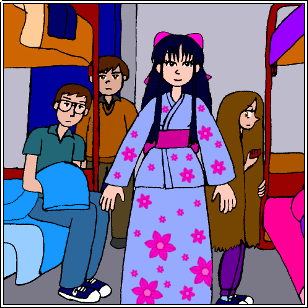#187: Time to go - 2010-08-27

After breakfast, Hugo took an old coat, some trousers and a hat that grandfather Lucas forgot at the house, and dressed Sapocop with them. What remained from the robot's battery was consumed on the way to the Gutiérrez house; that family was in the middle of a practice session.
Hugo and Pedro kept attending Karate classes regularly, but they hadn't attended since January 11. Eliana abandoned classes in late september, and after her hunger strike she decided to practice on her own while she was recovering. Rosa, meanwhile, didn't want anything to do with martial arts since quite a while.
When Hugo saw Carola, he hugged her and cried. Later, he handed her a bag that contained Sapocop's remote control and an operations manual. Carola promised him that, next time they leave the country, they'll go together alone. Hugo thanked Carola for her gesture, but didn't believe in her words.
All what remained of the day was spent by the Martínez Gómez family on getting ready for the journey.

Rosa dusted off the yukata that grandmother Atsuko gave her when she was teleported to Japan. She had used it a couple times, but it's not suitable to go outside at an one-horse chilean town, because ignorant people would tell her bad things like “Geisha”. A geisha is an artist, not what the West thinks. And geisha use white makeup (Rosa never uses makeup), and they use Shimada hairstyle (not the Hime-like hairstyle with a ribbon on the hair), often a wig. And they're all japanese (except an australian that succeded at becoming a geisha in 2007).
The yukata is a summer dress, used mostly in special situations. The word literally means “dress for [after] bath”, though its use isn't limited to that. Rosa wears the yukata because Atsuko gave it to her, to honor her japanese blood, and to withstand the heat that awaits her in Santiago.
As she was getting her baggage ready, Rosa finds an empty dish, that she used to feed Mimí. The cat was with the grandparents, since January 14; they're unreachable, and they still haven't returned the money to their daughter. If Clara's identity document had been at that wallet, the promptly passport renewal - and, therefore, the trip to Japan - would have been impossible.
At sunset, a mailman stopped at the Martínez Gomez house. That was a certified card, whose sender was a travel agency at Las Condes, Santiago. The envelope contained a form, some cards with colored images, and a notebook page with big red letters that read:
“ THESE DOCUMENTS COSTED ME AROUND A MILLION PESOS. DON'T LOSE THEM. - 西田 温子”
At the reverse, the page had a handwritten message, giving instructions about how to use all these papers. The form, in English and Japanese, must be filled by each member of the family, and must be shown along with the passport and the colored cards, in order to receive passes to use japanese trains (JAPAN RAIL PASS). Those passes can't be bought inside Japan, so they must watch for them with the same care as the passport.
Once the backpacks were ready with clothes and food for the trip, the family went to sleep, early. The following day, they left on the first bus towards Santiago.
